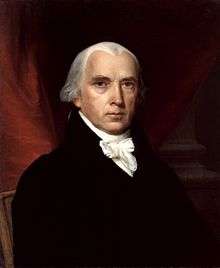1809 in the United States
| 1809 in the United States | |
|---|---|
| Years: | 1806 1807 1808 – 1809 – 1810 1811 1812 |
|
| |
 The Star Spangled Banner, 15 stars, 15 stripes (1795–1818) | |
|
Timeline of United States history
| |
Events from the year 1809 in the United States.
Incumbents
Federal Government
- President: Thomas Jefferson (DR-Virginia) (until March 4), James Madison (DR-Virginia) (starting March 4)
- Vice President: George Clinton (DR-New York)
- Chief Justice: John Marshall (Virginia)
- Speaker of the House of Representatives: Joseph Bradley Varnum (DR-Massachusetts)
- Congress: 10th (until March 4), 11th (starting March 4)
Events

March 4: James Madison begins the first of two terms as President
- February 3 – The Illinois Territory is created.
- February 11 – Robert Fulton patents the steamboat.
- February 17 – Miami University (Ohio) is established on the township of land required to be set aside for it under the conditions of the Miami Purchase in 1794.
- February 20 – A decision by the Supreme Court of the United States states that the power of the federal government is greater than any individual state.
- March 4 – James Madison succeeds Thomas Jefferson as the President of the United States.
- May 5 – Mary Dixon Kies becomes the first recipient of a patent granted to a woman by the United States Patent and Trademark Office. She invented a technique of weaving straw with silk and thread.[1]
- October 11 – Along the Natchez Trace in Tennessee, explorer Meriwether Lewis dies under mysterious circumstances at an inn called Grinder's Stand. It is considered an alleged suicide though some evidence suggests murder.
- December 30 – Wearing masks at balls is forbidden in Boston, Massachusetts.
Undated
- Following refitting, the USS Constitution ("Old Ironsides") is recommissioned as the flagship of the North Atlantic Squadron.[2]
Births
- January 19 – Edgar Allan Poe, author, poet, editor and literary critic (died 1849)
- February 12 – Abraham Lincoln, 16th President of the United States from 1861 till 1865 (died 1865)
- April 21 – Robert M. T. Hunter, Virginian lawyer, politician, 14th Speaker of the United States House of Representatives, 2nd Confederate States Secretary of State (died 1887)
- July 24 – Charles W. Cathcart, Portugal-born United States Senator from Indiana from 1845 to 1853 (died 1888)
- August 15 – Albert Pike, Confederate military officer, attorney, writer, and Freemason (died 1891)
- August 27 – Hannibal Hamlin, the 15th Vice President of the United States from 1861 to 1865 (died 1891)
- September 20 – Sterling Price, 11th Governor of Missouri, United States Army brigadier general in the Mexican-American War, Confederate Army major general in the American Civil War (died 1867)
- September 27 – Raphael Semmes, officer in the Confederate navy during the American Civil War (died 1877)
- December 5 – Graham N. Fitch, United States Senator from Indiana from 1857 to 1861 (died 1892)
- December 10 – George Goldthwaite, United States Senator from Alabama from 1871 till 1877 (died 1879)
Deaths
- June 8 – Thomas Paine, political activist, philosopher, Founding Father of the United States, author of Common Sense (born 1737)
- October 11 – Meriwether Lewis, leader of the Corps of Discovery (born 1774)
References
- ↑ "Mary Kies - Patenting Pioneer". Retrieved 2007-05-14.
- ↑ Ramsdell, Lorraine. "USS Constitution, The History". The United States Navy.
Further reading
- William S. Appleton, Robert C. Winthrop. "Original Bank Circular, 1809". Proceedings of the Massachusetts Historical Society, Vol. 11, (1869–1870)
- Thomas H. Shoemaker. A List of the Inhabitants of Germantown and Chestnut Hill in 1809. The Pennsylvania Magazine of History and Biography, Vol. 16, No. 1 (April, 1892), pp. 42–63
- An Itinerary to Niagara Falls in 1809. The Pennsylvania Magazine of History and Biography, Vol. 24, No. 2 (1900), pp. 200–202
- Ellmore Barce. Governor Harrison and the Treaty of Fort Wayne, 1809. Indiana Magazine of History, Vol. 11, No. 4 (1915), pp. 352–367
- Charles Lyon Chandler. United States Shipping in the La Plata Region, 1809-1810. The Hispanic American Historical Review, Vol. 3, No. 2 (May 1920), pp. 159–176
- Joshua Gilpin. Journal of a Tour from Philadelphia Thro the Western Counties of Pennsylvania in the Months of September and October, 1809. The Pennsylvania Magazine of History and Biography, Vol. 50, No. 1 (1926), pp. 64–78
- A trip from Fort Wayne to Fort Dearborn in 1809. Indiana Magazine of History, Vol. 36, No. 1 (1940), pp. 45–51
- Edwin J. Hipkiss. A Cabinetmaker's Bill: Boston, 1809. Bulletin of the Museum of Fine Arts, Vol. 45, No. 259 (February, 1947), pp. 12–14
- Noble E. Cunningham Jr. The Diary of Frances Few, 1808-1809. The Journal of Southern History, Vol. 29, No. 3 (August, 1963), pp. 345–361
- William G. McLoughlin. Thomas Jefferson and the Beginning of Cherokee Nationalism, 1806 to 1809. The William and Mary Quarterly, Third Series, Vol. 32, No. 4 (October, 1975), pp. 548–580.
- Jeffrey A. Frankel. The 1807-1809 Embargo Against Great Britain. The Journal of Economic History, Vol. 42, No. 2 (June, 1982), pp. 291–308.
- James M. O'Toole. From Advent to Easter: Catholic Preaching in New York City, 1808-1809. Church History, Vol. 63, No. 3 (September, 1994), pp. 365–377
External links
-
 Media related to 1809 in the United States at Wikimedia Commons
Media related to 1809 in the United States at Wikimedia Commons
This article is issued from Wikipedia - version of the 11/17/2016. The text is available under the Creative Commons Attribution/Share Alike but additional terms may apply for the media files.